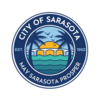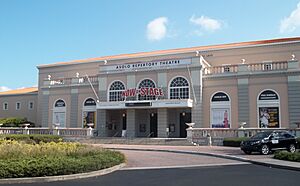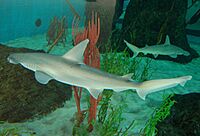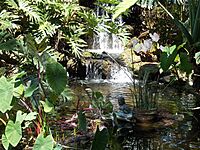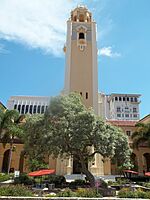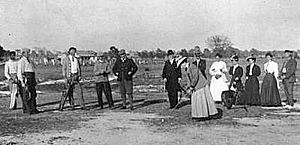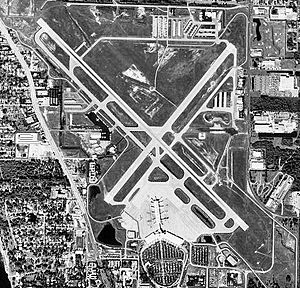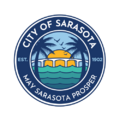Sarasota, Florida facts for kids
Quick facts for kids
Sarasota, Florida
|
|||
|---|---|---|---|
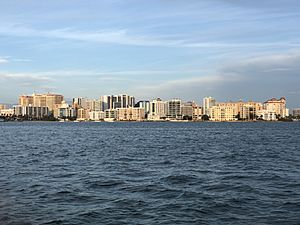
Skyline of Sarasota from Bird Key in 2018
|
|||
|
|||
| Nickname(s):
Paradise, SRQ, Circus City
|
|||
| Motto(s):
"May Sarasota Prosper",
"Where Urban Amenities Meet Small-Town Living" |
|||
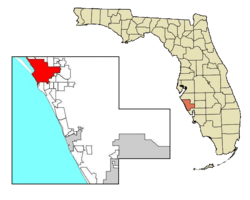
Location in Sarasota County and the U.S. state of Florida
|
|||
| Country | |||
| State | |||
| County | Sarasota | ||
| Zarazote | 1539 | ||
| Fort Armistead | 1840 | ||
| Sara Sota | 1842 | ||
| Sarasota (town) | October 14, 1902 | ||
| Sarasota (city) | May 13, 1913 | ||
| Government | |||
| • Type | Commission–Manager | ||
| Area | |||
| • City | 24.08 sq mi (62.38 km2) | ||
| • Land | 14.70 sq mi (38.07 km2) | ||
| • Water | 9.39 sq mi (24.31 km2) 42.58% | ||
| Elevation | 16 ft (7 m) | ||
| Population
(2020)
|
|||
| • City | 54,842 | ||
| • Density | 3,731.51/sq mi (1,440.74/km2) | ||
| • Urban | 779,075 (US: 57th) | ||
| • Urban density | 1,927.1/sq mi (744.0/km2) | ||
| • Metro | 833,716 (US: 71st) | ||
| • Metro density | 542.0/sq mi (209.3/km2) | ||
| Time zone | UTC−5 (EST) | ||
| • Summer (DST) | UTC−4 (EDT) | ||
| ZIP codes |
34230–34243, 34249, 34260, 34276-34277
|
||
| Area code(s) | 941 | ||
| FIPS code | 12-64175 | ||
| GNIS feature ID | 0290675 | ||
Sarasota (/ˌsærəˈsoʊtə/) is a city in Sarasota County, Florida, United States. It is the main city of the North Port-Bradenton-Sarasota metropolitan area. Sarasota is located in Southwest Florida, south of Tampa Bay and north of Fort Myers.
The city includes parts of Sarasota Bay and several islands between the bay and the Gulf of Mexico. These islands are called keys. Some of these keys are Lido Key, St. Armands Key, and the northern part of Siesta Key. Longboat Key is the largest island here, but it is a separate town.
In the early 1900s, Sarasota grew very quickly. Its city limits expanded to almost 70 square miles (180 km2). However, a real estate crash in 1926 caused the city to shrink to less than a quarter of that size.
Contents
- Exploring Sarasota's Past
- Sarasota's Geography and Climate
- Who Lives in Sarasota?
- Arts and Culture in Sarasota
- Festivals and Events in Sarasota
- Sarasota's Architecture and Historic Places
- Learning in Sarasota
- Media and News in Sarasota
- Sports and Fun in Sarasota
- Getting Around Sarasota
- Sarasota's Sister Cities
- Images for kids
- See also
Exploring Sarasota's Past
How Did Sarasota Get Its Name?
The name Sarasota first appeared on a Spanish map in 1763 as "Zarazote." This name covered the areas of present-day Sarasota and Bradenton. There are different ideas about where the name came from. Some people think it was named after Sara, the daughter of explorer Hernando de Soto. Others believe it came from the Calusa tribe's language, meaning "an area of land easily observed."
When Was Sarasota Founded?
Around 1883 to 1885, a company from Scotland bought a lot of land in Sarasota to develop it. Many Scottish people moved to Sarasota in December 1885. Sarasota officially became a town on October 14, 1902. John Hamilton Gillespie was the first Mayor. Later, on May 13, 1913, it became a city, and A. B. Edwards became its first city mayor.
Sarasota's Geography and Climate
What is Sarasota's Climate Like?
Sarasota has a humid subtropical climate. This means it has hot, humid summers and cooler, mild winters. In summer, the high temperatures and humidity often make it feel hotter than 100 °F (38 °C).
Understanding Rainy and Dry Seasons
Sarasota has clear rainy and dry seasons. The rainy season lasts from March to November. The dry season is from December to February. The city's total area is about 24.08 square miles (62.4 km2), with 14.70 square miles (38.1 km2) of land and 9.39 square miles (24.3 km2) of water.
The Gulf Intracoastal Waterway
The Gulf Intracoastal Waterway connects the entire Sarasota Bay system. It includes natural deep water areas and human-made channels and canals.
Who Lives in Sarasota?
| Historical population | |||
|---|---|---|---|
| Census | Pop. | %± | |
| 1910 | 840 | — | |
| 1920 | 2,149 | 155.8% | |
| 1930 | 8,398 | 290.8% | |
| 1940 | 11,141 | 32.7% | |
| 1950 | 18,896 | 69.6% | |
| 1960 | 34,083 | 80.4% | |
| 1970 | 40,237 | 18.1% | |
| 1980 | 48,868 | 21.5% | |
| 1990 | 50,961 | 4.3% | |
| 2000 | 52,715 | 3.4% | |
| 2010 | 51,917 | −1.5% | |
| 2020 | 54,842 | 5.6% | |
| Source | |||
| Race | Pop 2010 | Pop 2020 | % 2010 | % 2020 |
|---|---|---|---|---|
| White (NH) | 34,052 | 34,575 | 65.59% | 63.04% |
| Black or African American (NH) | 7,558 | 6,611 | 14.56% | 12.05% |
| Native American or Alaska Native (NH) | 118 | 101 | 0.23% | 0.18% |
| Asian (NH) | 676 | 1,676 | 1.30% | 3.06% |
| Pacific Islander or Native Hawaiian (NH) | 15 | 32 | 0.03% | 0.06% |
| Some other race (NH) | 99 | 306 | 0.19% | 0.56% |
| Two or more races/Multiracial (NH) | 765 | 1,716 | 1.47% | 3.13% |
| Hispanic or Latino (any race) | 8,634 | 9,825 | 16.63% | 17.92% |
| Total | 51,917 | 54,842 | 100.00% | 100.00% |
In 2020, Sarasota had 54,842 people living there. About 14.6% of the population was under 18 years old. Also, 28.0% of the people were 65 years or older. More than half of the population (52.5%) were female.
Many people in Sarasota have completed high school (90.0%). About 37.2% of people over 25 years old have a college degree.
Arts and Culture in Sarasota
Sarasota is known for its many performing and visual arts. It has a rich history in music, dance, theater, and circus arts.
Performing Arts: Music, Dance, and Theater
Sarasota offers many places to enjoy live performances. These include the Sarasota Ballet, Sarasota Opera, and Asolo Repertory Theatre. Other venues are Florida Studio Theatre, the Players Centre for Performing Arts, and the Westcoast Black Theatre Troupe.
Historic Theaters and Halls
In 1925, A. B. Edwards built a theater for both live shows and movies. Famous performers like Tommy Dorsey, Will Rogers, and Elvis Presley performed there. This building is now the Sarasota Opera House. It has been restored and is used for opera and other shows. It is listed as a historic place.
In the 1950s, the John and Mable Ringling Museum of Art bought an old Italian theater called the "Asolo." This theater was built in Italy in 1798 for Queen Caterina's palace. It was taken apart in 1931 and then rebuilt in Sarasota.
In the 1960s, Lewis and Eugenia Van Wezel helped the city build a large performing arts hall. The Van Wezel Performing Arts Hall was designed by a team from Frank Lloyd Wright's firm. Wright's widow, Olgivanna Lloyd Wright, chose its unique purple color.
Modern Performance Spaces
In 1989, another Asolo Theater was built at the Florida State University Center for the Performing Arts. This complex has multiple theaters and is used by students from Florida State University's acting programs.
The Keating Theatre, part of Florida Studio Theatre, is one of Sarasota's oldest buildings. It was once the Sarasota Woman's Club, built in 1915. It served as the town's first library and hosted many community events. In 1985, it was added to the National Register of Historic Places.
Florida Studio Theatre also bought the Gompertz Theatre in 2003. This building was a movie house in the 1920s. It later hosted various shows and performers before becoming a theater again.
Sarasota's Music Scene
Sarasota is home to the Sarasota Orchestra, founded in 1949. It hosts a three-week Sarasota Music Festival that attracts famous teachers and students. The city also has Key Chorale and Choral Artists of Sarasota. The Jazz Club of Sarasota is one of the largest jazz clubs in the United States.
Many famous musicians have lived in Sarasota, including Joe Perry of Aerosmith and Brian Johnson of AC/DC.
Visual Arts: Museums and More

Sarasota is a hub for fine art, filmmaking, and circus history. The Sarasota Art Museum and the Ringling Museum are both located here.
Sarasota: The Circus City
Sarasota is often called "Circus City" because John Ringling moved the winter headquarters of the Ringling Bros. and Barnum & Bailey Circus here in 1927. The John and Mable Ringling Museum of Art has a Circus Museum and the Tibbals Learning Center.
The Circus Arts Conservatory in Sarasota puts on the Circus Sarasota show and runs Sailor Circus, the "oldest youth circus." The Showfolks Club also hosts an annual circus performance.
The Circus Ring of Fame is in St. Armand's Circle. It honors important people in circus history with special plaques, like the Hollywood Walk of Fame.
Sarasota on the Big Screen
Many movies have been filmed in Sarasota. In 1952, Cecil B. DeMille filmed and premiered The Greatest Show on Earth here. Later, Great Expectations (1998) and Palmetto (1998) were also filmed in the city.
Out of Time (2003), starring Denzel Washington, used locations like the Blackburn Point Bridge. In 2013, Parker, with Jason Statham and Jennifer Lopez, filmed scenes at Ca' d'Zan in Sarasota.
Aquariums, Zoos, and Gardens
Sarasota is home to several attractions focused on nature and animals. These include Mote Marine Laboratory, which is a marine research and rescue facility with an aquarium. You can also visit the Marie Selby Botanical Gardens, the Sarasota Jungle Gardens, and the Big Cat Habitat & Gulf Coast Sanctuary.
Festivals and Events in Sarasota
Film and Improv Festivals
Since 1998, Sarasota has hosted the annual Sarasota Film Festival. This festival showcases independent films from around the world. It is one of Florida's largest film festivals.
Florida Studio Theatre also produces the annual Sarasota Improv Festival. This festival brings together improv performers from across the country and even from other parts of the world.
Chalk and Arts Festivals
In 2010, the Sarasota Chalk Festival became the first international street painting festival in the United States. Artists create amazing chalk art on the streets. The festival has different themes each year and introduces new street art techniques.
The Fabulous Arts Foundation hosts an independent music festival that supports civil rights and focuses on the LGBTQ community. It is held every May and includes music, art shows, and film screenings.
Sarasota's Architecture and Historic Places
Italian-Inspired Buildings
Many homes and buildings in Sarasota are designed in the Italian style. The John and Mable Ringling Museum of Art and Ringling's home, Cà d'Zan, are good examples. These buildings were inspired by Venetian architecture. You can also find Italian-inspired statues, like a copy of Michelangelo's David at the museum, which is a symbol of Sarasota.
The Sarasota School of Architecture
The Sarasota School of Architecture is a unique style of modern architecture. It combines ideas from Bauhaus and Frank Lloyd Wright's "organic" architecture. This style was developed to fit Sarasota's sub-tropical climate. It used new materials that became available after World War II.
Preserving Historic Buildings
Over time, many older buildings in Sarasota were torn down. However, some historic buildings have been saved. The Crocker Church and the Bidwell-Wood House (the oldest building in the city) were moved to a park to protect them.
The Terrace Hotel, built by Charles Ringling, was bought by Sarasota County in the late 1970s and turned into a government office building. The courthouse next to it is also a historic landmark.
The Municipal Auditorium-Recreation Club, built in 1937, was carefully restored in the 1990s. It is now a popular place for sports, concerts, and community events. The old Federal Building was also restored.
Unfortunately, many important buildings from the "Sarasota School of Architecture" period have been lost. They are often not old enough to be protected by historic preservation rules. For example, Paul Rudolph's Riverview High School was torn down in 2009, despite efforts to save it.
In 2019, a former Sarasota High School building was turned into the Sarasota Art Museum of Ringling College. This renovation cost about $30 million.
Unique Cultural Features
The Pinecraft neighborhood in Sarasota is home to an Amish-Mennonite community. This community is unusual because it includes many elderly people who moved to Florida for the mild climate. It also has Amish people on holiday and those who don't fit into other Amish communities.
The Rosemary District was historically an African American community and is now home to the Boulevard of the Arts. Newtown is another historically African American neighborhood.
Learning in Sarasota
Public Schools
Public education in Sarasota is managed by the Sarasota County Public Schools district.
Elementary schools include:
- Alta Vista Elementary School
- Ashton Elementary School
- Bay Haven School of Basics Plus
- Brentwood Elementary School
- Emma E. Booker Elementary
- Fruitville Elementary School
- Gocio Elementary School
- Gulf Gate Elementary School
- Lakeview Elementary School
- Laurel Nokomis School
- Phillippi Shores Elementary School
- Southside Elementary School
- Tatum Ridge Elementary School
- Tuttle Elementary School
- Wilkinson Elementary School
Middle schools include Booker Middle School, Brookside Middle School, Laurel Nokomis School, McIntosh Middle School, and Sarasota Middle School.
High schools include Booker High School, Pine View School for the Gifted, Riverview High School, Sarasota High School, Suncoast Polytechnical High School, Sarasota Military Academy, and Oak Park School.
Private Schools
Some private schools in Sarasota are:
- Ascension Lutheran School
- The Classical Academy of Sarasota
- Sarasota Christian School
- Cardinal Mooney Catholic High School
- Out-of-Door Academy
Colleges and Universities
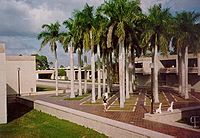
Sarasota is home to New College of Florida, a public liberal arts college.
Other colleges include Keiser University of Sarasota and Ringling College of Art and Design. There are also satellite campuses of Eckerd College and Florida State University College of Medicine.
Media and News in Sarasota
Television and Radio
Sarasota is part of the Tampa-Saint Petersburg-Sarasota television market. WWSB is the local ABC-affiliated station. SNN: Suncoast News Network provides continuous local cable news.
Sarasota has several radio stations. These include WSMR (classical music), WSLR-LP (variety-talk), and WSRZ (oldies). Many radio stations from the Tampa Bay area also serve Sarasota.
Newspapers
The Sarasota Herald-Tribune is the daily newspaper in Sarasota. The Sarasota Observer is a weekly newspaper. The Bradenton Herald also covers Sarasota news.
Sports and Fun in Sarasota
Sports Teams and Venues
Soccer
Sarasota has an amateur soccer team called the Sarasota Paradise. They play in the USL League Two at Charlie Cleland Stadium.
Stadiums and Fields
The Municipal Auditorium-Recreation Club, built in 1937, is a center for sports and recreation. It hosts activities like badminton, basketball, and shuffleboard.
Ed Smith Stadium is where the Baltimore Orioles baseball team holds their spring training every year. The Orioles also have minor league facilities nearby.
Golf
Sarasota's warm climate makes it a great place for golf. John Hamilton Gillespie was one of the first to play golf here. Many golf courses are in the area, including the Sara Bay course designed by Donald Ross.
Fishing
Sport fishing is very popular in Sarasota Bay. People come to catch fish like Tarpon and gigantic gar.
Running and Swimming
The Sarasota Marathon started in 2005. It is now a half marathon race that begins and ends near the Ringling Museum.
Sarasota has two competitive swim teams, the Sarasota Sharks and the Sarasota Tsunami. Both teams are nationally recognized.
Sailing and Rowing
The Sarasota Sailing Squadron hosts many sailing races for different types of boats.
Nathan Benderson Park has a special lake for rowing. It has hosted major events like the World Rowing Championships in 2017 and trials for the U.S. Olympic rowing teams.
Baseball
Sarasota and Bradenton together hosted the 2021 U-18 Baseball World Cup.
Other Fun Activities
Sarasota hosts the Whiskey Obsession Festival, the largest whiskey festival in Florida. It features hundreds of whiskies from around the world.
Water Skiing
The Sarasota Ski-A-Rees are an amateur water ski show team. They started in 1957 and perform free water ski shows weekly at Ken Thompson Park. They won the National Show Ski Championships in 2017.
Getting Around Sarasota
Airports
The main airport is Sarasota-Bradenton International Airport (SRQ). It opened in 1941 and serves over 1.3 million passengers each year. It has flights to places in the United States and Canada. Larger airports like Tampa International Airport are about an hour north.
Public Transportation
Sarasota County Area Transit offers a bus service called Breeze. It covers the county and connects to nearby Manatee County. Sarasota County is also planning future transportation like light rail and commuter rail.
Trains
There is no Amtrak train station directly in Sarasota. However, Amtrak provides a bus service from Sarasota to the nearest train station in Tampa. A freight-only rail line serves industries in Sarasota.
Water Travel
Sarasota is on the Gulf of Mexico, so water transportation is important. The Intracoastal Waterway provides water access for boats. Nearby deep water ports include Port Manatee and the Port of Tampa.
Roads
Major roads in Sarasota include:
 I-75 – This is the only freeway, located about 5 miles (8.0 km) east of downtown Sarasota. It goes north to Tampa and south to Miami.
I-75 – This is the only freeway, located about 5 miles (8.0 km) east of downtown Sarasota. It goes north to Tampa and south to Miami. U.S. 41 (Tamiami Trail) – A main north-south road that runs through Sarasota, often parallel to the coast.
U.S. 41 (Tamiami Trail) – A main north-south road that runs through Sarasota, often parallel to the coast. U.S. 301 – This road runs north from U.S. 41, parallel to it, until they merge again in Manatee County.
U.S. 301 – This road runs north from U.S. 41, parallel to it, until they merge again in Manatee County. SR 780 (Fruitville Road) – A key east-west road connecting U.S. 41, U.S. 301, and I-75.
SR 780 (Fruitville Road) – A key east-west road connecting U.S. 41, U.S. 301, and I-75. SR 789 – This road starts as John Ringling Causeway, goes to Bird Key and Lido Key, and then heads north as Gulf of Mexico Drive on the islands.
SR 789 – This road starts as John Ringling Causeway, goes to Bird Key and Lido Key, and then heads north as Gulf of Mexico Drive on the islands.
Sarasota's Sister Cities
The U.S. sister city program helps communities in different countries become partners. Sarasota has several sister cities around the world:
 Perpignan, France (since 1994)
Perpignan, France (since 1994) Vladimir, Russia (since 1994, currently suspended)
Vladimir, Russia (since 1994, currently suspended) Tel Mond, Israel (since 1999)
Tel Mond, Israel (since 1999) Dunfermline, Scotland, UK (since 2001)
Dunfermline, Scotland, UK (since 2001) Siming District, China (since 2007)
Siming District, China (since 2007) Mérida, Mexico (since 2010)
Mérida, Mexico (since 2010)
Friendship Cities
Sarasota also has "friendship cities":
 Rapperswil-Jona, Switzerland (since 2017)
Rapperswil-Jona, Switzerland (since 2017) Busseto, Italy (since 2020)
Busseto, Italy (since 2020)
Images for kids
See also
 In Spanish: Sarasota para niños
In Spanish: Sarasota para niños



